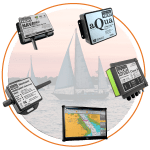With an AIS receiver or transponder, you will receive all information of surrounding ships and will allow you to contact them directly. There are 3 types of AIS data that are automatically and continuously transmitted:
- Dynamic data: position and speed which are automatically calculated by the transponder.
- Static data: MMSI, ship name, size and contact details. This data is programmed on the device.
- Voyage data (only for class A transponder): Destination, ETA, number on board and navigation status. This data is programmed on the class A transponder before and during each voyage.
The data transmission frequency is different depending on the transponder category and the speed of the ship.
The AIS targets can be displayed in different ways:
- On a multifunction plotter/screen using the NMEA interface of an AIS receiver/transponder.
- On a PC/MAC navigation software thanks to a NMEA/USB adapter or an AIS receiver/transponder with an integrated USB interface.
- On an iOS/Android navigation application via a NMEA to WiFi server or an AIS receiver/transponder with integrated WiFi interface.
Each system will display the AIS targets differently (colours, size, etc.) but the data will remain the same. The next tab will explain which AIS transponder you need depending on the system you want to use to display the AIS targets.
 United Kingdom
United Kingdom United States
United States France
France Australia
Australia Germany
Germany Spain
Spain Europe
Europe



